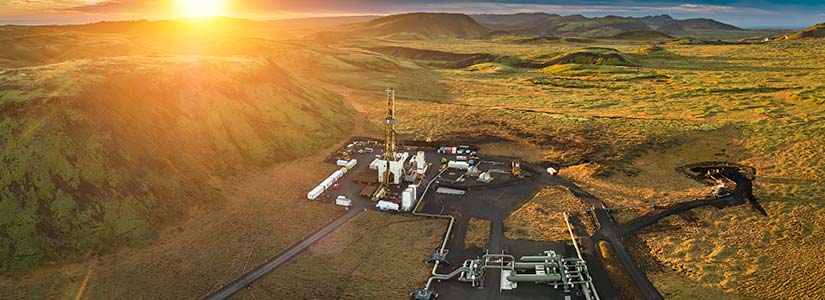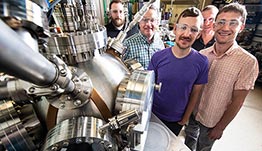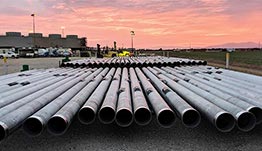Advanced Wells
NLR and its partners are reinventing the future of geothermal drilling and advanced wells.

As deeper and hotter geothermal resources are targeted, NLR is focused on improving today’s drilling and well construction technologies. Photo from Ragnar Th. Sigurdsson
Drilling, constructing, and operating wells in harsh geothermal environments requires advanced techniques and technologies relative to drilling for water or oil and gas. As developers target deeper and hotter resources—as well as elaborate well designs—technologies and efficiency also need to improve.
High-Temperature, High-Pressure Tools
Downhole drilling tools significantly improve the accuracy of data. Surface measurements are impaired by boundary effects because of torque and drag alongside the drill string, torsional drill-string wrapping, and drilling dysfunctions. These effects make it challenging to discern true downhole bit conditions. Downhole data collection in the oil and gas industry has decreased drilling time and costs while increasing penetration rates by 35%–55%. NLR scientists are using new materials and designs to increase the temperature and pressure capability of these tools for use in high-temperature (>250°C) geothermal wells.
Innovative Drilling Systems
NLR researchers are working to advance high-temperature/hard-rock geothermal drilling. Rotary drilling has been used to drill wells of all types for more than a century. Over this time, advances have led to faster drilling rates, which have increasingly allowed for economic access to oil and gas plays throughout the world. However, geothermal heat is often found in harder, hotter, and potentially deeper rock. Although recent drilling projects in Utah and California have recorded significant improvements in rates of penetration and bit life, there are still vast opportunities to improve drilling performance and efficiency through improved bit design, novel drilling methods, and data-informed operations.
Well Construction Materials
NLR is using its expertise in ceramics, metallurgy, and polymer development to advance well construction materials and designs.
Unlike short-lived oil and gas wells, geothermal wells must last decades under constant use, harsh conditions, and thermal cycling. The higher the well temperature, the more economically attractive the geothermal well is. It is therefore important that the geothermal industry develop well materials (both casing and cement backing) that can survive for years in harsh geothermal environments. NLR works with partners on well construction materials capable of withstanding very high geothermal temperatures (>300°C), pressures and salinities.
Geothermal Energy From Oil and Gas Wells
NLR experts are working to use geothermal resources in combination with fossil energy. Geothermal and oil and gas hybrid systems make use of wells already drilled by oil and gas developers, creating synergies in these related industries. Coproducing energy from oil and gas reservoirs producing large amounts of hot water is considered for some projects. Using geothermal fluids from these wells for energy production (i.e., direct-use heating or electricity) can extend the economic life of existing wells and deliver near-term energy savings.
Oil and Gas Wells for Energy Storage
NLR researchers are advancing opportunities to repurpose inactive and abandoned oil and gas wells to store energy. Using wells that are already located near existing grid infrastructure offers a potentially lower-cost approach to enhancing grid resilience than building new energy storage. Geothermal researchers have contributed subsurface expertise to industry collaborations, including the co-creation of gravity well technology that uses the vertical space within repurposed wells to discharge potential energy by lifting and lowering weights.
Featured Projects
In the RePED 250 project, NLR researchers are working to adapt Tetra Innovation Institute's patented pulsed power drilling technology to the hotter, harder, crystalline rock found in geothermal wells using high-temperature power electronics, including alternators, capacitors, and high-voltage, pulsed-power switches. If successful, the technology is expected to disrupt the global drilling industry and replace traditional drilling technologies within 10 years of commercialization.
Competitive market modeling shows the potential for an additional 50 GW of geothermal deployed in the United States because of cost and time improvements from this technology. High-temperature power electronics developed through this research will also have immediate applicability to industries including petroleum, aviation, fuel cells, vehicles, smart grid, and the military.
Impact
This technology would increase drilling rates tenfold, reduce geothermal well drilling costs by 75%, and cut development timelines, significantly increasing the market competitiveness of geothermal power.
Partners
Tetra Innovation Institute, TPL Inc., and the University of New Mexico
NLR is developing a new generation of electronics for harsh environments and specifically focusing on sensors, interface electronics, and packaging for downhole applications. Gallium oxide-based electronics have the potential for very high-temperature operation, so initial work has focused on developing sensors for downhole applications. To accomplish this also requires the development and qualification of new high-temperature contact metallurgies and robust packaging. We are investigating new inorganic and polymer composite encapsulants for both the sensor packages and downhole casing applications.
The objectives of NLR's materials for harsh geothermal environments effort are to:
- Develop next-generation sensors and power electronics based on gallium oxide and other functional oxides
- Develop thermodynamically and mechanically stable contacts for harsh environments
- Develop packaging for downhole environments based on novel tunable composites
- Validate the performance of new packaged electronics in downhole conditions
- Develop new approaches to stabilizing well casings for significantly longer downhole lifetimes.
Impact
Increased downhole sensor temperature limits facilitate geothermal drilling efficiency by incorporating NLR's aluminum gallium nitride materials in high-temperature sensing electronics.
Partners
National Oilwell Varco
The Repurposing Infrastructure for Gravity Storage using Underground Potential energy (RIGS UP) project aims to repurpose inactive (idle and orphaned) oil, gas, and geothermal wells for gravity-based energy storage.
The storage system, otherwise known as a gravity well (GrW), consists of a drivetrain that lowers a multiton weight within a vertical wellbore or the vertical section of a deviated/horizontal well. NLR is collaborating with a pioneer partner in this field, Renewell Energy, to design an optimal drivetrain—consisting of an electric motor, variable speed drive, winch drum, wire rope, and gearbox—that will result in minimal mechanical and thermal losses.
NLR is also supporting technology to market efforts that will accelerate commercial readiness of the GrW system. This includes the creation of a database of wells that currently are, or could be in the future, repurposed as GrWs.
Impact
Giving a second life to inactive wells via a gravity-based storage system with this project funded by ARPA-E. NLR's aluminum gallium nitride materials in high-temperature sensing electronics.
Partners
Renewell Energy
Four existing oil and gas wells in Oklahoma will be repurposed to produce geothermal energy for direct-use applications, serving heating and cooling demand in elementary and middle schools as well as 250 nearby houses in Tuttle, Oklahoma.
A publication featured in Energy Conversion and Management by NLR researchers and colleagues at the University of Oklahoma found that a system of repurposed oil and gas wells was cost-competitive with the regional natural gas rate. Further, recycling existing oil and gas wells would result in $7 million in cost savings.
Impact
Repurposing existing oil and gas wells for geothermal district energy system is techno-economically feasible ($68/MWh) and makes a positive impact on grid flexibility.
Partners
Lawrence Berkeley National Laboratory and Idaho National Laboratory
This active high water-cut Blackburn Oilfield in Nevada produces thousands of barrels of hot water per day that are discarded via re-injection. By using Organic Rankine Cycle generators, some of this energy can be captured and converted into electricity. Next steps include the development of a surface network design and deployment of one pilot scenario.
Impact
Proof-of-concept project will support the implementation of geothermal energy production in existing oil fields.
Partners
Transitional Energy, Grant Canyon Oil and Gas, Electratherm
Capabilities
NLR works with industry partners to design cost-effective drilling technologies that will enable the deployment of deeper and hotter geothermal across the United States. NLR's geothermal capabilities run the gamut from analysis to downhole tools/sensors and from reservoir modeling to full-scale field research validation. NLR also works with industry partners to evaluate the feasibility of using existing oil and gas wells for geothermal energy or storage applications. Learn more about these advanced wells capabilities:
Using its expertise in drilling and lean practices, NLR partners with industry to identify ways to reduce drilling costs by as much as 50%.
Declining oil prices in the late 1990s led to investments in drilling in an attempt to increase efficiency and decrease costs. The effort, which applied the principles of lean manufacturing to drilling, was successfully implemented by the onshore petroleum industry in the U.S. with a focus on standardization, optimization, and automation. The application of lean methodology to drilling realized cost savings of up to 50% and time savings of 15%–70%—even in hard-rock areas.
The largest savings have come from lean drilling processes, which can incur up to twice the planning man-hours of a traditional process. Successfully implementing lean methodology to the drilling process requires a significant change in mindset as well as the full support of all levels of a company, including managers, drilling contractors, operators, subsurface personnel, and drilling engineers.
NLR is working with geothermal operators to bring lean processes to the geothermal drilling industry. Time and experience have shown that significant savings are possible. If widely implemented, these savings could significantly increase profit margins and spark significant growth in the global geothermal industry.
Publications
Geothermal Drilling and Completions: Petroleum Practices Technology Transfer, NLR Technical Report (2018)
Geothermal Drilling: A Baseline Study of Nonproductive Time Related to Lost Circulation, 42nd Workshop on Geothermal Reservoir Engineering (2017)
Completion Design Considerations for a Horizontal Enhanced Geothermal System, Transactions (2015)
Contact
Dayo Akindipe
[email protected]
From new materials to new form figures, from packaging to reliability and validation, we are expanding capabilities for high-temperature power and sensing electronics.

Geothermal drilling is plagued by nonproductive time related to lost circulation, drill bit trips, and inefficiencies due to low rates of penetration and damaging drilling dynamics. Drilling time can be reduced by 50% by optimizing geothermal drilling through new sensing and electronics technologies. Downhole, high-temperature, and extended-range sensing downhole sensors can measure position, vibration, weight on bit, rotational speeds, and rock mechanics to facilitate drilling with higher efficiency, more reliability, and more range. Current downhole sensor technology is not reliable over 150°C, while anticipated drilling environments for geothermal surpass 400°C. The key to realizing lower drilling costs is the development of robust sensor packages that are survivable and provide data to improve efficiency.
NLR's research covers all aspects of sensor and power/signal electronics, including materials, contact metallurgies, and packaging. These components integrate to provide a downhole electronic platform capable of withstanding temperature, mechanical, and chemical stressors.
Patents
High Temperature and High Pressure AlGaN/GaN Electronics
Composite Packaging for Extreme Environments
Publications
Stable Contact Development for High-Temperature β-Ga2O3 Device Operation, APS March Meeting (2023)
Development of a 250 Degree C 15kV Supercascode Switch Using SiC JFET Technology, 2022 IEEE 9th Workshop on Wide Bandgap Power Devices and Applications (2022)
Contact
NLR's material science expertise spans the energy spectrum, allowing our scientists to leverage learning across industries.
Novel Cements

In the field of ceramics, our researchers have developed novel cements that emulate the durable ancient Roman cements of two millennia ago. These cements leverage the high temperatures of the subsurface (and some unique feedstocks) to form crystalline products that behave as a robust matrix with low permeability. The combination of low permeability, thermal resilience, and resistance to chemical attack indicate that this new (old) class of material may be integral in the future of geothermal cementing.
Casing Materials

Metal casing material is important for ensuring leak-free, constant geothermal production with no impact to shallow groundwater sources. NLR has developed processes to harden mild steel, which will limit the impacts of abrasion. In typical mild steel, scratches can act as a nucleating point for corrosive processes, so limiting abrasion is important for extending the life of inexpensive metal components downhole.
Also important to extending casing lifetime is limiting the steel's exposure to working fluid. NLR researchers are developing novel polymer-oxide composite materials that are extremely chemically stable and effective even above 350°C. The goal is to coat steel components with the chemically resistant composites to make casings that have the strength and cost of steel with the inertness of state-of-the-art alloys. Coupling robust cement backing with hardened and encased steel casings could greatly extend the lifetime of geothermal wells and make them more economically competitive and technically viable.
Publications
Thermomechanical Modeling of High-Temperature Bonded Interface Materials, Die-Attach Materials for High-Temperature Applications in Microelectronics Packaging, Springer Nature Link (2019)
Metal-Organic-Inorganic Nanocomposite Thermal Interface Materials With Ultralow Thermal Resistances, American Chemical Society Applied Materials and Interfaces (2017)
Reliability of Emerging Bonded Interface Materials for Large-Area Attachments, IEEE Transactions on Components, Packaging, and Manufacturing Technology (2016)
Contact
Oil and gas wells have been constructed and operated across the United States and have significant potential to coproduce thermal energy and be repurposed for geothermal energy systems, such as district heating system. Research projects at NLR have covered a range of topics within this area, from data collection to impact analysis.
Capabilities
Subsurface characterization
Characterize geothermal resource potential in oil and gas fields—such as geothermal gradient, geological formations, and geochemistry—and develop 3D conceptual geological and thermal models supported by legacy oil and gas data, exploration reports, well logs, and current field tests to assess locations of subsurface structures and heat reservesUnconventional geothermal drilling and well operations
Apply knowledge of petroleum drilling technologies, such as directional drilling, to model hot brine production from conventional oil well designsReservoir modeling
Develop reservoir models informed by the characterized subsurface, thermophysical properties of local rocks, and known reservoir properties to simulate long-term thermal energy production, production temperature, and thermal drawdownEconomic analysis
Analyze economic metrics—such as capital cost, net present value, and levelized cost of heating—of the geothermal system repurposed from oil and gas wellsImpact analysis
Evaluate the grid and other impacts of geothermal energy production from oil and gas wells
Publications
Geothermal Reservoir Simulation Analysis in Support of Electricity Co-Production Feasibility Study at the Blackburn Oil Field, Nevada: Preprint, Geothermal Rising Conference (2024)
Evolution of a Geological Model for Co-Producing Electricity at the Blackburn Oil Field, Nevada: Preprint, Stanford Geothermal Workshop (2024)
Techno-Economic Feasibility of Geothermal Energy Production Using Inactive Oil and Gas Wells for District Heating and Cooling Systems in Tuttle, Oklahoma, Energy Conversion and Management (2024)
Grid Resilience Analysis on Geothermal District Heating and Cooling Implementation Alongside Four Existing Oil and Gas Wells in Tuttle, Oklahoma, Geothermal Rising Conference (2024)
Impact of Geothermal District Heating System on Flexibility of Microgrid in Tuttle, Oklahoma, Geothermal Rising Conference (2024)
Techno-Economic Analysis for a Potential Geothermal District Heating System in Tuttle, Oklahoma, Geothermal Rising Conference (2023)
Subsurface Characterization for Evaluating Geothermal Resource Potential from Existing Oil and Gas Wells in Tuttle, Oklahoma, Geothermal Rising Conference (2023)Contact
Share
Last Updated Dec. 3, 2025
